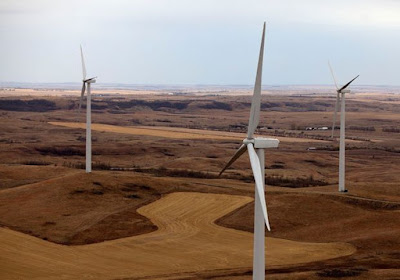 |
| Jill Shaffer of the U.S. Geological Survey authored the longest-ever study of the effect of wind turbines on prairie grasslands birds |
While we wait with fingers crossed for Saskatchewan Environment Minister Herb Cox to release his decision on the Chaplin Wind Energy project (see other Grass Notes stories here), the case against installing wind energy projects on native grassland is gaining ground.
 |
| From Saskatchewan Ministry of Environment's web page on the Chaplin Project |
A study released last summer by the United States Geological Survey makes it clear that installing wind turbines in native grassland is bad for the birds--not because birds may fly into the turning blades, but because by avoiding the disturbed areas--roads, gravel pads, the massive turbines--grassland birds are displaced and lose their critical breeding habitat.
Here is a report in the Bismarck Tribune, which describes the study as the longest of its kind. Beginning in 2003, the research compares grassland bird data on three sites of native grassland before and after the installation of wind turbines.
Looking at nine species of birds the researchers found that "seven of [them], including the meadowlark and the bobolink, were displaced from good breeding habitat for the study’s duration."
“New wind energy in prime wildlife habitat can influence the distribution of grassland birds for years after construction, including species whose populations are in serious decline,” the report concludes.
 |
| this image from the Bismarck Tribune shows one of the three study areas |
Thanks to Candace Savage, author of Geography of Blood and Prairie: A Natural History, for alerting me to this report.
Kevin Van Tighem, well known Alberta conservationist and author, posted this comment online in reference to the study:
"In southern Alberta wind projects have been located too often in large tracts of fescue grassland. The result is to fragment previously continuous habitat, eliminate aerial singers like Sprague's pipit and horned lark, and displace species like long-billed curlew and upland sandpiper that need large tracts of intact prairie. Wind can be green energy, but not when projects are put on the last good tracts of healthy prairie."
Saskatchewan can learn from the mistakes made in North Dakota and Alberta (and on our own native grasslands in the Missouri Coteau) by making sure that from now on, SaskPower and the provincial government will not support or approve wind energy projects on native grassland.











